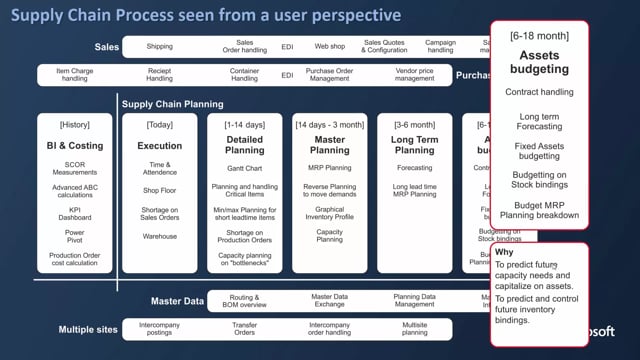
Playlists Manage
Log in to create a playlist or see your existing playlists.
Log inHow to do do Long Term Planning, Master Planning and Detailed Planning in Business Central?
Let me run through the different planning horizons and provide a suggestion for why you would do planning in those horizons, in those time frames.
This is what happens in the video
So we’ll start with the assets budgeting. Why would you do assets budgeting?
Well, it’s a long-term thing and you need to break down your expected forecast into requirements to figure out what are my bindings, expected bindings on stock, what are my expectation for capacities I need to do. Do I have to or need to buy new equipment if I have a growth strategy for instance, or should I sell equipment if I have the opposite.
So it’s about predicting what will happen in the very long term that we need to change our assets into and you can do that using Business Central somehow to do this breakdown.
Then you have the long-term planning and the period for the long-term planning will differ from company to company but the point is here to make some kind of sales forecasting or typically you would forecast on your sales items and then break down the requirements.
So you would know exactly what your requirements are, not exactly, but you know what your expected requirements will be in the longer terms, and that way, it’s possible to do agreement with vendors for items, plan to go agreement or frame agreement with the vendor.
So typically this is a demand because the procurement time is often longer than the expected sales lead time. So we need to do some kind of forecasting to break it down.
On the 2 weeks to 3 months period, we would like to run master planning and that will be, for instance, MRP 1 planning, MRP 2 planning, and it’s about figuring out what are my requirements for materials and what are my requirements for capacity?
And the point, of course, is to avoid stock out on items in demand and to gain high service level and low inventory binding. So the complex stuff about bringing your inventory down as low as possible is very important in this phase as well.
The detailed planning is about how we actually make the specific production plans. So this will be a production planner typically using Gantt Charts or whatever capacity planning algorithms to figure out do we have enough capacity? Do we have enough labor? Do we have enough item at the right time to start the production orders? And what is the load on the machinery, the capacities?
And is it possible to make a plan that we can actually execute? So the detailed planning is all the possible and often it turns in to be very manual.
Then there’s the execution phase in the supply chain process and we’d like to have some time and attendance, maybe Shop Floor. We’d like to have different kind of tools to figure out if we have shortages on production orders and sales orders if we could start the orders.
And the point is here, of course, to handle the material flow and a clever way into collect time measurement and production to be able to calculate how we perform in the production environment.
And of course, it’s about making good quality and having good data to continue improving our way of working.
And of course in the history, we’d like to see what we did actually and did it make value or can be optimized things. Is our routing correctly setup? Do we have too much waste that we need to look into and how we actually doing to improve?
So this is about being more able to figure out how to do forecasting in the long-term planning next time. So this are the phases on the supply chain where we need to do some kind of planning.

